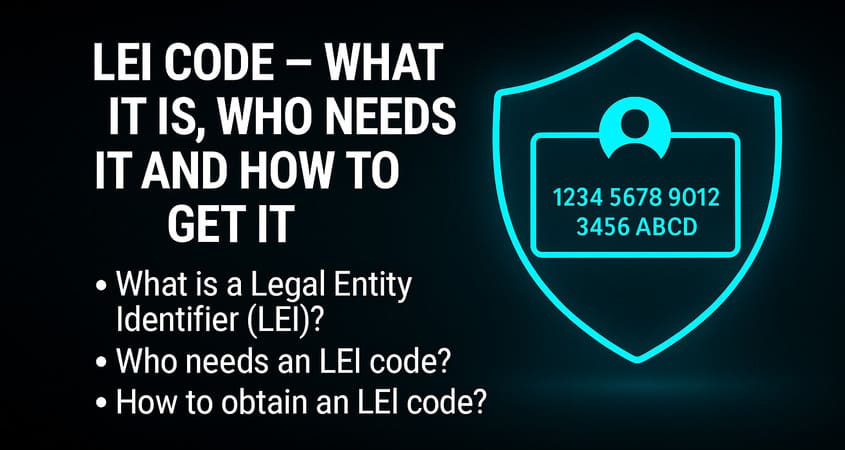LEI Code – What it is? Who needs it? And how to get it?

In today’s global digital economy, systems that enable the unambiguous identification of legal entities worldwide are becoming increasingly important. One such solution is the LEI – Legal Entity Identifier, an international identifier for financial institutions, companies, and other entities participating in economic transactions.
The LEI code serves a similar function for companies as the PESEL number does for individuals – it is a global, unique identifier that ensures transparency and security in business and financial relations.
Table of Contents
Toggle1. What is the LEI code (Legal Entity Identifier)?
The LEI code is a 20-character alphanumeric identifier assigned to every legal entity participating in financial transactions. It was introduced after the 2008 financial crisis as part of financial supervision and risk management reforms. Its primary goal is to standardize the identification of organizations across global markets – enabling the tracking of capital flows, analyzing corporate relationships, and preventing financial misconduct.
2. Structure of the LEI number
Each LEI code consists of 20 alphanumeric characters that follow a defined structure:
- XXXX – 4 characters identifying the Local Operating Unit (LOU) that issued the code
- YYYYYY… – characters representing the individual entity identifier
- ZZ – two check digits compliant with the ISO/IEC 7064 algorithm
Example LEI code: 529900T8BM49AURSDO55
3. Who must have an LEI code?
According to EU regulations (MiFID II / MiFIR) and GLEIF requirements, the LEI code is mandatory for all legal entities that:
- execute transactions involving financial instruments (e.g. shares, bonds, derivatives),
- participate in the financial market (e.g. investment funds, brokerage houses, banks),
- issue securities or act as counterparties reporting data to trade repositories,
- are part of corporate groups reporting to ESMA or EBA.
The absence of a valid LEI code prevents the execution of financial transactions – financial institutions are legally required to refuse orders from entities without an active LEI number.
4. Who can (but does not have to) have an LEI?
Although not all organizations are required to have one, many companies voluntarily obtain an LEI code to:
- increase credibility and transparency toward business partners,
- participate in international tenders or projects,
- verify legal identity under KYC/AML procedures,
- build trust in business and financial relationships.
Examples include limited liability companies, foundations, universities, or non-profit organizations operating in the grant sector.
5. How to obtain an LEI code step by step?
The process of obtaining an LEI code is simple and fully digital.
On HEXSSL.COM, you can complete the entire procedure in just a few minutes.
Step 1: Complete the registration form
Provide your company identification data: name, tax number, registered address, and contact details of the authorized person.
Step 2: Data verification
The information is automatically verified in GLEIF databases and relevant national registers or international equivalents.
Step 3: LEI code issuance
After successful verification, the system generates a unique LEI code and submits it to the global GLEIF database.
The entire process usually takes from a few minutes to a few hours.
Step 4: Publication in the register
Once activated, the entity’s data becomes publicly visible in the GLEIF.org database – anyone can verify the authenticity of the LEI number.
6. How much does an LEI code cost and how long is it valid?
The LEI code is issued for 12 months. After this period, it must be renewed to remain active in the global register.
The cost of the LEI code depends on the chosen provider, service scope, and registration period (1-5 years).
At HEXSSL we offer:
- LEI registration starting from $48.96 USD net in a 3-year plan,
- attractive renewal discounts,
- invoice options in PLN, EUR, or USD,
- full support in Polish, English, and German.
7. LEI code renewal – why is it important?
An expired LEI code results in an immediate suspension of reporting capabilities.
Many companies postpone renewal until the last moment, which may lead to:
- reporting disruptions to ESMA/EBA,
- administrative penalties,
- issues with banks or financial partners.
HEXSSL provides automatic renewal reminders, eliminating the risk of LEI code expiration.
8. Why obtain your LEI code through HEXSSL?
- 🔒 Secure registration process (SSL/TLS encryption).
- ⚡ Fast activation (in as little as 15 minutes).
- 💬 Local support and VAT invoices.
- 💰 Transparent pricing and no hidden fees.
- 🔁 Automatic renewal option available.
HEXSSL combines expertise in digital security (SSL) and entity identification (LEI), ensuring that the registration and management process is as simple as possible.
Today, the LEI code is not only a legal requirement for financial market participants but also a tool for building trust in the digital economy.
Just as an SSL certificate secures communication between a user and a website, the LEI code ensures transparency in relations between companies.
➡️ Register your LEI code at HEXSSL.COM and gain confidence that your company is visible, identified, and trustworthy in the global GLEIF system.
